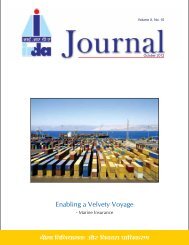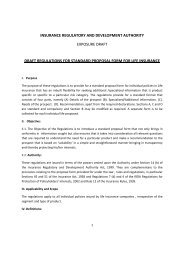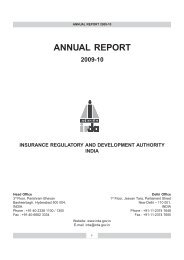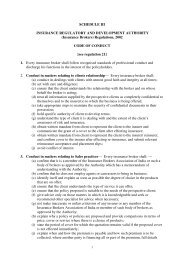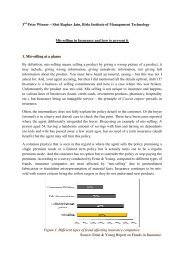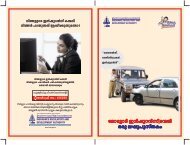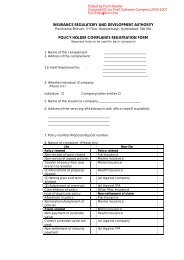Download PDF - IRDA
Download PDF - IRDA
Download PDF - IRDA
You also want an ePaper? Increase the reach of your titles
YUMPU automatically turns print PDFs into web optimized ePapers that Google loves.
ANNUAL REPORT 2011-12<br />
PART - I<br />
POLICIES AND PROGRAMME<br />
I.1 GENERAL ECONOMIC ENVIRONMENT<br />
I.1.1 The Indian economy grew at the rate of 6.5 per<br />
cent in 2011-12. It is the lowest growth rate achieved<br />
in the past nine year period. Such dismal growth was<br />
preceded by two successive years of robust growth of<br />
8.4 per cent. The slowdown in economy was refl ected<br />
across all sectors of the Indian economy, but the<br />
weakest performance was reported in the industrial<br />
sector. During 2011-12, the agricultural sector grew at<br />
the rate of 2.8 per cent, substantially lower than the<br />
growth of 7.0 per cent recorded in the previous year.<br />
The year 2010-11 saw simultaneous occurrence of a<br />
normal and well distributed south-west monsoon as<br />
also an excess north-east monsoon, which was not<br />
observed in the last decade. The north-east monsoon<br />
witnessed a deficit by 48 per cent in 2011-12, although<br />
the south-west monsoon remained normal during<br />
2011-12. With this the production level of foodgrains<br />
stood at 257.4 million tonnes in 2011-12 (244.8 million<br />
tonnes in 2010-11).<br />
I.1.2 The industrial sector reported a growth rate of<br />
2.6 per cent during 2011-12, as compared to 6.8 per<br />
cent of previous year and an average growth rate of<br />
6.3 per cent in the last fi ve years. The slowdown in<br />
industrial production appeared to be across all subsectors<br />
except electricity leading to the slowdown in<br />
overall growth of the economy during 2011-12. Various<br />
macro-economic factors, such as, the moderation in<br />
demand (both domestic and external), hardening of<br />
interest rates, slowdown in consumption expenditure,<br />
especially in interest rate sensitive commodities,<br />
subdued business confi dence and global economic<br />
uncertainty contributed to the weakening of Indian<br />
economy.<br />
I.1.3 The services sector, the main contributor of<br />
India’s success story in recent years, reported slower<br />
growth of 8.5 per cent compared to 9.2 per cent growth<br />
achieved in the previous year. The deceleration in<br />
services sector appeared to be on account of both<br />
weakening demand as well as inter-linkages with the<br />
industrial sector. The savings and investment rates<br />
continued to decline. The average savings rate has<br />
witnessed consistent decline since 2008-09, led by a<br />
sharp decline in public sector savings rate, which was<br />
not offset by private savings. As per the preliminary<br />
estimates of RBI, the net fi nancial savings of the<br />
household sector reduced to 7.8 per cent of GDP in<br />
2011-12 from 9.3 per cent in the previous year and<br />
12.2 per cent in 2009-10. This moderation in the net<br />
fi nancial savings rate of the household sector during<br />
the year mainly refl ected an absolute decline in small<br />
savings and slower growth in households’ holdings of<br />
bank deposits, currency as well as life funds.<br />
Furthermore, with real interest rates on bank deposits<br />
and instruments such as small savings remaining<br />
relatively low on account of the persistent high inflation,<br />
and the stock market adversely impacted by global<br />
developments, households seemed to have favored<br />
investment in valuables such as gold, which impacted<br />
the pace of their investment in physical assets such<br />
as housing in 2011-12 (RBI Annual Report, 2011-12).<br />
I.1.4 The headline infl ation rate continued to rule at<br />
high levels. It remained high at 9.6 per cent and 8.9<br />
per cent during 2010-11 and 2011-12 respectively, as<br />
measured through annual average Wholesale Price<br />
Index (WPI). These levels appeared to be very high<br />
as compared to the same for the average of last 10<br />
years (2000-01 to 2009-10), which remained at a<br />
substantially low level at 5.4 per cent. Due to high<br />
infl ation rate, Reserve Bank continued its stance of<br />
high interest rates. Comparatively, interest rates<br />
hovered at higher levels in 2011-12, as compared to<br />
2010-11. The average Call Money rate stood at 8.2<br />
per cent in 2011-12 compared to 5.8 per cent in the<br />
previous year. The yield on 10-year Government<br />
Securities hovered at around 8.4 per cent in 2011-12,<br />
higher from the 7.9 per cent of previous year. The<br />
weighted average interest rate on Central Government<br />
Borrowings went up from 7.9 per cent in 2010-11 to<br />
8.5 per cent in 2011-12.<br />
I.1.5 The benchmark defi cit indicators widened in<br />
2011-12 on account of many external and domestic<br />
15



